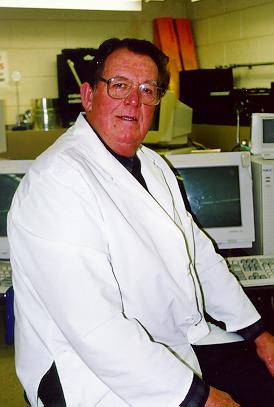VGCC’s Teacher Of The Year Certainly Has The Credentials

Figuratively speaking, James J. Tart should be over the moon about being named Vance-Granville Community College’s Teacher of the Year.
Literally speaking, he was one of the engineers who helped put other Americans not just over but on the moon.
Tart, 65, is program head for Electronics Engineering at VGCC. He has been at the college since 1985, and head of the department since 1987. His engineering expertise was sharpened at the National Aeronautics and Space Administration during the “glory days” of the Space Race.
After graduating from Henderson High School and meeting wife-to-be Elizabeth Lee of Oxford, Tart joined the Air Force. A recruit aptitude test indicated that he had a knack for airborne electronics and he was sent to the finest school the Air Force offered in that specialty.
After he finished his tour, he attended the Capitol Radio Engineering Institute in Washington, D.C., and then went to work for what was then known as the National Advisory Committee for Aeronautics in Langley, Va.
During the Eisenhower administration, Tart said, NASA became the National Aeronautics and Space Administration, where he would work through part of the 1950s and 60s.
At Langley, Tart worked on the Scout research rocket, designed to assess the chance of humans surviving space travel.
He recalled a vehicle to the moon that ejected radio transmitters that bounced “all over the place,” gathering data.
“When it blasted off, it took the top layer off the concrete,” Tart said of the rocket.
“Sputnik had put a fire under NASA,” he said, referring to the launch of the first Russian satellite.
Tart was also among the engineers who wrestled with re-entry problems.
“When it came back in, we would lose communication with the men. It was known as radio blackout.” Tart is credited with helping solve that problem.
He has great admiration for the first seven NASA astronauts. Their predecessors were monkeys, among them Sam and Miss Sam.
“The astronauts didn’t want the monkeys to go. They wanted to be on the first launches. After all, they were test pilots. Even then, they knew they were risking their lives. They were the Columbuses, the Marco Polos,” he said.
“Langley was the heart of NASA until we got a Massachusetts president and a Texas vice-president.” With the Kennedy, Johnson administration, he said, much of the program was moved to Cape Canaveral and the Johnson Space Center.
Asked about difficulties NASA has had lately, including the loss of a Mars’s probe in October, Tart said, “They need a spark. Something to lobby with.”
Tart himself left NASA for more down-to-earth pursuits.
“Like so many, I wanted to go into private business, which was a mistake.” He bought into a conglomerate of businesses, unrelated to electronics. “It was more work than money.”
Tart and family came back to Henderson because “it was home.” He was hired by Vance-Granville to teach, something he had also done during his time with NASA.
To enter the college’s electronics engineering program, one should have a high school diploma and “as much math as you can get.” Also physics, which, he said, gets short shrift in high schools.
The community college will help interested students fill in the educational gaps. But they should not try to remediate and enroll at the same time.
Is the two-year program worth the effort?
After students finish, he said, “They can go to UNC-Charlotte or Western Carolina and get a B.S. in two years. They day they walk in, they’re juniors.
North Carolina State, however, would say, “You should have come here first.” You would have to “examine in” at State, he said.
That’s because State emphasizes engineering instead of engineering technology. Engineering is strictly theoretical,” Tart said. “With engineering technology, you able to theorize and design and build.”
How employable are students who just complete the two-year program?
“You’ll get scooped up immediately.” UNC has just hired one of his students, he said. “The top of his pay scale is better than mine, and he’s heading that way.
“Nortel came one year and took a good portion of the class,” he said.
Closer to home, graduates of Tart’s program are at Iams and Harriet & Henderson Yarns, Inc.
But is engineering technology fun?
“Where other people talk about the computer’s motherboard, we get in and troubleshoot them. Isn’t that more fun that just sitting in front of one?”
He admits that hard-core science can seem forbidding. He promises his students that they will understand the mysterious equations in their texts before they leave the course.
“Don’t let the student run,” he advises. “Don’t intimidate them. Bring them along slowly.”
Out of 58 nominees, Tart was one of 12 finalists for the state’s Excellence in Teaching award.
“The teaching part is exciting, but the personal relationships are wonderful. I get both ends of it.”
He and his wife are building a house not far from the college. After retirement, at an unspecified date, they would like to travel. But it may not be a clean break.
“Have you noticed that when teachers retire around here, they don’t retire? They come back part time. It must be because they love it. It’s habit-forming.”
Tart and his wife have one child, daughter Beverly Joette Yancey, and one granddaughter, Julie Susanne Yancey.

